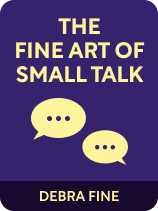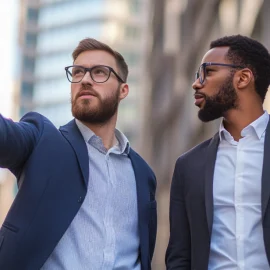

This article is an excerpt from the Shortform book guide to "The Fine Art of Small Talk" by Debra Fine. Shortform has the world's best summaries and analyses of books you should be reading.
Like this article? Sign up for a free trial here .
Want advice on how to ask someone on a date? What do you do if you get turned down?
Asking someone on a date can be nerve-wracking—especially when you’re afraid of being turned down. Additionally, when planning the date, you should always provide full details rather than trying to surprise them and pick an activity where you can converse in a casual environment.
Here are more tips from The Fine Art of Small Talk on how to ask someone out.
How to Ask Them Out
The purpose of dating, according to Fine, is to learn about each other, discover what it’s like to be around each other, and enjoy each other’s company. In short, you want to know if this is a person you’d enjoy spending some greater portion of your life with. As such, Fine says, plan dates that maximize your ability to interact, converse, and connect. Before you ask someone out, Fine recommends thinking of a few casual dates—activities you’d enjoy engaging in with a friend. Be prepared to provide the full details up front.
(Shortform note: When it comes to planning dates, Fine suggests you prioritize conversing and connecting. However, to really help your partner to open up, it’s arguably more important to prioritize their feeling of safety and comfort. As such, don’t try to surprise your date: Always share the full details when you extend your invitation. Make sure the date is safe and casual; there shouldn’t be anything about the venue or activity that involves danger or threat. Further, be flexible—offering multiple date options allows you to work around your schedules, as well as the possibility that your partner may not be comfortable with your first suggestion. Finally, be understanding: The other person has every right to say “no,” and if you can’t accept that, you’re not ready to date.)
Here’s how to ask someone on a date: When you make the call to arrange the date, Fine says it’s important to remind your potential date of who you are: Refresh their memory of specific things that happened when you met, and tell them what you enjoyed about the time you spent together. Let them know you’d like to connect with them again, and then offer your date idea.
Here’s an example conversation:
- Andrew: “Hi Julia, it’s Andrew; we met at the speed dating event at Barlowe’s last week.”
- Julia: “Oh, hi Andrew, it’s nice to hear from you again!”
- Andrew: “Julia, I really enjoyed hearing about your experience working for the Monterey Bay Aquarium; I’m still chuckling about what you said about penguins.. I was hoping we might get a chance to hang out again sometime soon.”
- Julia: “That would be fun! I’ve been wanting to hear more about your volunteering at the raptor center..”
- Andrew: “Well, would you be interested in joining me for a walk around Bowness Park on Saturday? There’s a little coffee shop there that makes really nice pastries. We could go, say, around ten?”
- Julia: “That sounds great! I’ll text you on Friday afternoon and we can decide where to meet.”
(Shortform note: Fine’s advice here is arguably outdated as phone etiquette has changed since this book was published in 2005. Indeed, millennials—and those younger than them—often prefer to avoid phone calls at all costs, arguing that they’re a rude, inefficient, and time-wasting imposition. Therefore, it’s generally considered polite to schedule a call in advance by sending a text message, or to forgo a call entirely. Further, contrary to Fine’s recommendations, it’s best to get straight to the point in conversations like these—because your date can just scroll up to see your conversational history, there’s no need to reintroduce yourself.)
If the other person turns you down, Fine says, don’t take it too personally—whatever their reason, they don’t know you well enough to warrant your feeling insulted or unappealing.
(Shortform note: This advice is perhaps easier said than done—research shows that rejection is processed by the same areas of the brain that handle physical pain, and dating rejection can be particularly excruciating because it highlights our insecurities. In overcoming this pain, be gentle with yourself: Don’t compound your pain with shame, self-criticism, and anger. Give yourself time to let go, and pursue calming, centering activities that take your mind off the rejection—spending time outdoors in natural, untamed environments is particularly helpful. Finally, remember that rewards don’t come without risk—so don’t let one rejection keep you from risking another.)
If you’re the one receiving the invitation, Fine asks that you be kind: Empathize with the emotional effort the other person is making. If you’re turning them down, be firm and polite.
(Shortform note: It can be scary to reject a date, so it’s tempting to be indirect or “gentle.” However, experts say it’s critical to establish a clear boundary by leaving no ambiguity. Further, you’re not obligated to give a reason: “No, thank you,” is enough. Even if you want to be particularly nice, don’t lose the clarity: “No, thank you; I think you’re lovely, but I’m just not feeling any chemistry.”)

———End of Preview———
Like what you just read? Read the rest of the world's best book summary and analysis of Debra Fine's "The Fine Art of Small Talk" at Shortform .
Here's what you'll find in our full The Fine Art of Small Talk summary :
- Why we need small talk and why we shouldn't avoid it
- How to appear confident and engaging in any context
- How to break the ice with strangers and keep the conversation going






